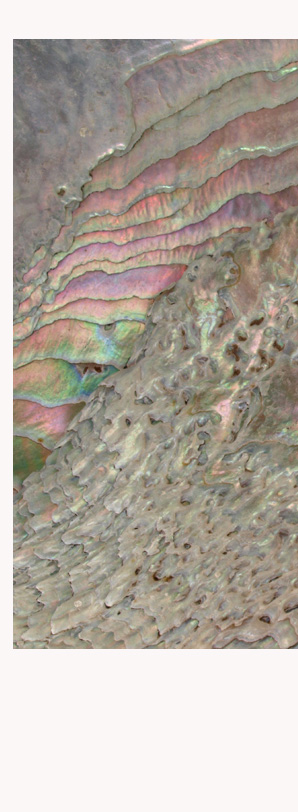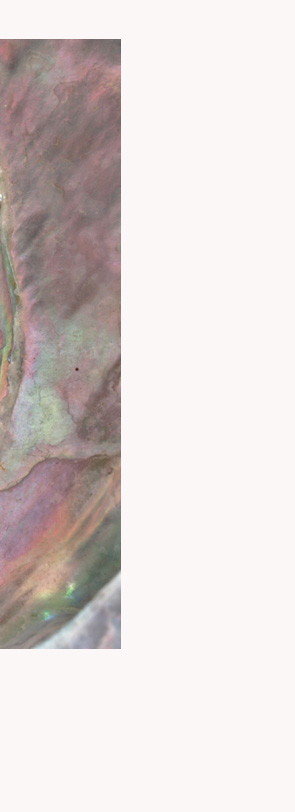 |
 |
 |
 |
| Sea Shell Colours A close-up by Andrew Kirk of California shows the soft iridescent colours of an abalone shell. ©Andrew Kirk, shown with permission. |
 |
 |
 |
 |

| About - Submit | Optics Picture of the Day | Galleries | Previous | Next | Today |
 |
|
| The source of sea shell and pearl colours has fascinated some of our most eminent physicists. Edinburgh and St Andrews scientist David Brewster is better known for his research on the polarization of light and other studies - not to mention the invention of the kaleidoscope! In the early 1800s he examined the reflection of a candle flame by mother- of- pearl. This deceptively simple experiment yielded important clues to the colour formation because he found that there were several coloured reflections � a sign of diffraction rather than pure reflection and refraction. An even more telling experiment was on a wax cast of the shell surface. The wax showed the colours too. Brewster considered that the colours were somehow �communicable�. They were: We see that the shell�s colours must somehow be produced by the structure of its surface � consistent with Brewster�s observation that the shell was finely grooved with ~3000 lines per inch. The shell's surface is a natural diffraction grating. In 1923, in one of the later papers of his life, Lord Rayleigh, a giant of physics, complicated the surface diffraction paradigm by observing that shells often had multiple layers of thin plates and that their colours could arise from another type of diffraction, multilayer interference. The great Indian physicist Chandrasekhara Venkata Raman reconciled the two views in 1934 and later in a series of publications in 1954 with Dharmaraja Krishnamurti. He saw that in many cases that the multiple internal layers were inclined to the surface and thus produced the regularly spaced surface grooves where they outcropped. Intriguingly, he showed, among much more detailed studies, that under those conditions the diffraction effects of the surface grooves and the internal multiple layers direct light in the same directions although the spectra differ. In the 21st Century, the physical structures and optical properties of shells continue to be studied. Shells are immensely strong with highly desirable mechanical properties that arise from their internal structure. Their colours are examples of structural colour, colours that arise from light scattering by complex nanostructures rather than simple absorption, refraction and reflection. They challenge optical theories and attempts to mimic them. |
| The lustrous nacre of the abalone shell is made up of polygonal (usually hexagonal) tiles of a very hard crystalline form of calcium carbonate, aragonite, cemented in a thin matrix of conchiolin � polysaccharide and protein fibres. The tiles are each a single crystal and are tessellated in stacked layers. Each layer is 0.5 micron thick. The individual tiles are about 10 micron across and their �c� optical axes are all perpendicular to the layer. The structure�s regularity is remarkable. Protein secretions control its formation. Initially there is random nucleation of aragonite on a thin protein layer. The fastest crystal growth would normally be perpendicular to the layer along the �c� axis but this is rather neatly prevented by the selective absorption of proteins onto the top crystal faces. Horizontal growth proceeds instead and contact with adjacent tiles eventually forces a regular spacing. Periodic injections of an inhibitor protein is hypothesised to limit the tile thickness to 0.5 micron. An upper terrace of crystal starts to form on the face of each tile and eventually grows into a second layer. And so on. |
| Stacked layers of aragonite tiles Regularly spaced surface grooves | |||
| The green bars represent 10 micron. Images ©T L Tan, D Wong & P Lee, Iridescence of a shell of mollusk Haliotis Glabra, Optics Express, Vol. 12, Issue 20, pp. 4847-4854 (2004) | |||
|
| D. Brewster, Treatise on Optics, in 1st American Edition Philadelphia, p102ff (1833) Lord Rayleigh, Studies of iridescent colour and the structures producing it. II Mother-of-pearl, Proc Roy Soc Lond A, 102, pp674-677 (1923) C V Raman, On iridescent shells - Parts I-III, Proc Indian Acad Sci A 1:pp567-589,859-870 (1934) C V Raman & D Krishnamurti, The structure and optical behaviour of iridescent shells, Proc Indian Acad Sci A 39: pp1-13 (1954) T L Tan, D Wong & P Lee, Iridescence of a shell of mollusk Haliotis Glabra, Optics Express, Vol. 12, Issue 20, pp. 4847-4854 (2004) A Lin, M A Meyers, Growth and structure in abalone shell, Materials Science and Engineering A 390, pp.27�41(2005) |